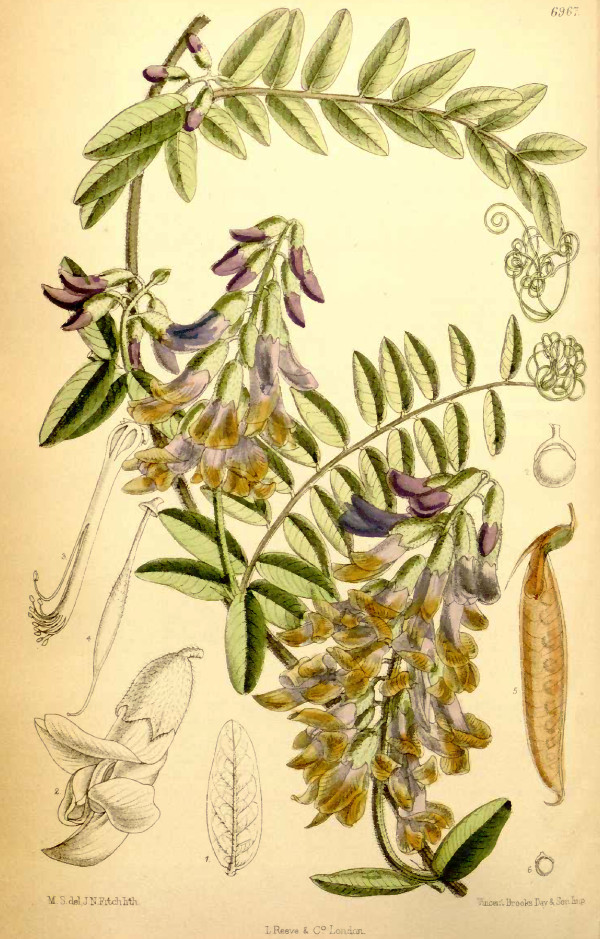Vicia dennesiana H.C.Watson (1870:154)
Taxonomy & Nomenclature
Conservation Status
Extinct (WCMC, 1992:220; Schaefer, 2003; Schaefer et al., 2012; Humphreys et al., 2019; Abeli et al., 2021; Albani Rocchetti et al., 2022; POWO, 2024; Christenhusz & Govaerts, 2025)
Last record (disputed): 1844-1849 (wild) (Schaefer, 2003:113); 1884 (Christenhusz & Govaerts, 2025); May 1887 (cultivation) (Hooker, 1887); 1922 (cultivation) (source)
This species has been identified as one of the 50 best candidates for de-extinction, ranking 10/50 (Albani Rocchetti et al., 2022).
Distribution & Habitat
São Miguel Island (& Corvo?), Azores
This species likely inhabited Corvo as well (Connor et al., 2024).
Biology & Ecology
Hypodigm
Media

Above: colour plate published in Hooker, 1887 (republished in Schaefer et al., 2012). Source: https://www.biodiversitylibrary.org/item/14241#page/166/mode/1up
References
Original scientific description:
Watson, H. C. (1870). In: Natural history of the Azores or Western Islands. Cane Godman F, editor. J. Van Voorst, London. Botany of the Azores; pp. 113-288.
Other references:
Abeli, Thomas, Albani Rocchetti, Giulia, Barina, Zoltan, Bazos, Ioannis, Draper, David, Grillas, Patrick, Iriondo, José María, Laguna, Emilio, Moreno-Saiz, Juan Carlos and Bartolucci, Fabrizio. (2021). Seventeen ‘extinct’ plant species back to conservation attention in Europe. Nature Plants 7: 282-286. https://doi.org/10.1038/s41477-021-00878-1
Albani Rocchetti, Giulia, Carta, Angelino, Mondoni, Andrea, Godefroid, Sandrine, Davis, Charles C., Caneva, Giulia, Albrecht, Matthew A., Alvarado, Karla, Bijmoer, Roxali, Borosova, Renata, Bräuchler, Christian, Breman, Elinor, Briggs, Marie, Buord, Stephane, Cave, Lynette H., Da Silva, Nílber Gonçalves, Davey, Alexandra H., Davies, Rachael M., Dickie, John B., Fabillo, Melodina, Fleischmann, Andreas, Franks, Andrew, Hall, Geoffrey, Kantvilas, Gintaras, Klak, Cornelia, Liu, Udayangani, Medina, Leopoldo, Reinhammar, Lars Gunnar, Sebola, Ramagwai J., Schönberger, Ines, Sweeney, Patrick, Voglmayr, Hermann, White, Adam, Wieringa, Jan J., Zippel, Elke Zippel and Abeli, Thomas. (2022). Selecting the best candidates for resurrecting extinct-in-the-wild plants from herbaria. Nature Plants 8: 1385-1393. https://doi.org/10.1038/s41477-022-01296-7 [Supplementary Tables S1-S6]
Christenhusz, Maarten J. M. and Govaerts, Rafaël. (2023). Uitgestorven. Op plantenjacht rond de wereld: 1-511. Sterck & De Vreese.
Christenhusz, Maarten J. M. and Govaerts, Rafaël. (2025). Plant extinction in the Anthropocene. Botanical Journal of the Linnean Society 207(3): 183-196. https://doi.org/10.1093/botlinnean/boae045 [Appendix S1]
Connor, Simon E. et al. (2024). Original plant diversity and ecosystems of a small, remote oceanic island (Corvo, Azores): Implications for biodiversity conservation. Biological Conservation 291: 110512. https://doi.org/10.1016/j.biocon.2024.110512
Hooker, Joseph Dalton. (1887). Vicia dennesiana. Curtis’s Botanical Magazine 43: t. 6967.
Humphreys, Aelys M., Govaerts, Rafaël, Ficinski, Sarah Z., Lughadha, Eimear Nic and Vorontsova, Maria S. (2019). Global dataset shows geography and life form predict modern plant extinction and rediscovery. Nature Ecology & Evolution 3: 1043-1047. https://doi.org/10.1038/s41559-019-0906-2 [Supplementary Dataset 1]
POWO. (2024). Vicia dennesiana H.C.Watson. Plants of the World Online (online resource). Facilitated by the Royal Botanic Gardens, Kew, United Kingdom. Available at: https://powo.science.kew.org/ [Accessed 28 February 2024]
Schaefer, Hanno. (2003). Chorology and diversity of the Azorean flora. J. Cramer, Stuttgart (Germany). (Dissertationes Botanicae 374).
Schäfer, Hanno. (2021). Flora of the Azores a field guide: 1-445. Margraf Publishers GmbH.
Schaefer, Hanno, Hechenleitner, Paulina, Santos-Guerra, Arnoldo, Menezes de Sequeira, Miguel, Pennington, R. Toby, Kenicer, Gregory and Carine, Mark A. (2012). Systematics, biogeography, and character evolution of the legume tribe Fabeae with special focus on the middle-Atlantic island lineages. BMC Ecology and Evolution 250(12): 250. https://doi.org/10.1186%2F1471-2148-12-250
Tutin, T. G. et al. (eds.). (1968). Flora Europaea 2: 1-469. Cambridge University Press.
Tutin, T. G. et al. (eds.). (1995). Flora Europaea electonic dataset
Walter, Kerry S. and Gillett, Harriet J. (eds.). (1998). 1997 IUCN Red List of Threatened Plants. Compiled by the World Conservation Monitoring Centre. Gland, Switzerland & Cambridge, UK: IUCN – The World Conservation Union. lxiv + 862 pp.
WCMC (World Conservation Monitoring Centre). (1992). Global Biodiversity: Status of the Earth's living resources. London: Chapman & Hall. xx + 594 pp.
